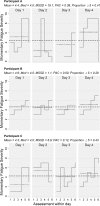Tracking daily fatigue fluctuations in multiple sclerosis: ecological momentary assessment provides unique insights
- PMID: 28281106
- PMCID: PMC5613039
- DOI: 10.1007/s10865-017-9840-4
Tracking daily fatigue fluctuations in multiple sclerosis: ecological momentary assessment provides unique insights
Abstract
Studies investigating the prevalence, cause, and consequence of multiple sclerosis (MS) fatigue typically use single measures that implicitly assume symptom-stability over time, neglecting information about if, when, and why severity fluctuates. We aimed to examine the extent of moment-to-moment and day-to-day variability in fatigue in relapsing-remitting MS and healthy individuals, and identify daily life determinants of fluctuations. Over 4 weekdays, 76 participants (38 relapsing-remitting MS; 38 controls) recruited from multiple sites provided real-time self-reports six times daily (n = 1661 observations analyzed) measuring fatigue severity, stressors, mood, and physical exertion, and daily self-reports of sleep quality. Fatigue fluctuations were evident in both groups. Fatigue was highest in relapsing-remitting MS, typically peaking in late-afternoon. In controls, fatigue started lower and increased steadily until bedtime. Real-time stressors and negative mood were associated with increased fatigue, and positive mood with decreased fatigue in both groups. Increased fatigue was related to physical exertion in relapsing-remitting MS, and poorer sleep quality in controls. In relapsing-remitting MS, fatigue fluctuates substantially over time. Many daily life determinants of fluctuations are similar in relapsing-remitting MS and healthy individuals (stressors, mood) but physical exertion seems more relevant in relapsing-remitting MS and sleep quality most relevant in healthy individuals.
Keywords: Affect; Ambulatory assessment; Ecological momentary assessment; Fatigue; Multiple sclerosis; Psychological stress.
Conflict of interest statement
Conflict of interest
Daniel J. H. Powell, Christina Liossi, Wolff Schlotz, and Rona Moss-Morris declares that they have no conflict of interest.
Human and animal rights and Informed consent
All procedures followed were in accordance with ethical standards of the responsible committee on human experimentation (institutional and national) and with the Helsinki Declaration of 1975, as revised in 2000. Informed consent was obtained from all patients for being included in the study.
Figures


Similar articles
-
Circadian cortisol and fatigue severity in relapsing-remitting multiple sclerosis.Psychoneuroendocrinology. 2015 Jun;56:120-31. doi: 10.1016/j.psyneuen.2015.03.010. Epub 2015 Mar 12. Psychoneuroendocrinology. 2015. PMID: 25817406
-
ACTIVE-FIT program: Assessment of sleep quality and its relationship with physical activity in patients with relapsing-remitting multiple sclerosis.Sleep Med. 2024 Jul;119:373-378. doi: 10.1016/j.sleep.2024.05.005. Epub 2024 May 8. Sleep Med. 2024. PMID: 38761606
-
Muscle Fatigability During a Sustained Index Finger Abduction and Depression Scores Are Associated With Perceived Fatigue in Patients With Relapsing-Remitting Multiple Sclerosis.Neurorehabil Neural Repair. 2015 Sep;29(8):796-802. doi: 10.1177/1545968314567151. Epub 2015 Jan 20. Neurorehabil Neural Repair. 2015. PMID: 25605633
-
Multiple sclerosis in children.Iran J Child Neurol. 2013 Spring;7(2):1-10. Iran J Child Neurol. 2013. PMID: 24665290 Free PMC article. Review.
-
Reporting guidelines on remotely collected electronic mood data in mood disorder (eMOOD)-recommendations.Transl Psychiatry. 2019 Jun 7;9(1):162. doi: 10.1038/s41398-019-0484-8. Transl Psychiatry. 2019. PMID: 31175283 Free PMC article. Review.
Cited by
-
Real-time associations among MS symptoms and cognitive dysfunction using ecological momentary assessment.Front Med (Lausanne). 2023 Jan 12;9:1049686. doi: 10.3389/fmed.2022.1049686. eCollection 2022. Front Med (Lausanne). 2023. PMID: 36714150 Free PMC article.
-
Ecological Momentary Assessment in Patients With an Acquired Brain Injury: A Pilot Study on Compliance and Fluctuations.Front Neurol. 2020 Mar 5;11:115. doi: 10.3389/fneur.2020.00115. eCollection 2020. Front Neurol. 2020. PMID: 32194494 Free PMC article.
-
Effects of repetitive twice-weekly transcranial direct current stimulations on fatigue and fatigability in people with multiple sclerosis.Sci Rep. 2023 Apr 11;13(1):5878. doi: 10.1038/s41598-023-32779-y. Sci Rep. 2023. PMID: 37041183 Free PMC article.
-
Dietary Patterns and Their Associations with Symptom Levels Among People with Multiple Sclerosis: A Real-World Digital Study.Neurol Ther. 2023 Aug;12(4):1335-1357. doi: 10.1007/s40120-023-00505-5. Epub 2023 Jun 13. Neurol Ther. 2023. PMID: 37311967 Free PMC article.
-
Understanding patterns of fatigue in health and disease: protocol for an ecological momentary assessment study using digital technologies.BMJ Open. 2024 May 27;14(5):e081416. doi: 10.1136/bmjopen-2023-081416. BMJ Open. 2024. PMID: 38802273 Free PMC article.
References
-
- Barta WD, Tennen H, Litt MD. Measurement reactivity in diary research. In: Mehl MR, Conner TS, editors. Handbook of research methods for studying daily life. New York, NY: Guilford Press; 2012.
-
- Black AC, Harel O, Matthews G. Techniques for analyzing intensive longitudinal data with missing values. In: Mehl MR, Conner TS, editors. Handbook of research methods for studying daily life. New York, NY: The Guilford Press; 2012.
MeSH terms
Grants and funding
LinkOut - more resources
Full Text Sources
Other Literature Sources
Medical

